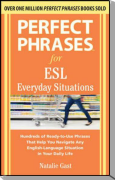
Everyday situations

| Book of the Month | ||
 |
Perfect Phrases for ESL Everyday situations |  |
Publisher: McGraw Hill
Author: Natalie Gast
$13.00
ISBN 0071770283
This 'Perfect Phrases' book is what used to be called a 'phrase book' - a set of common expressions in another language to look up so that you can say what you need to say to a native speaker. Evidently many users have found the 'Perfect Phrases' version of this to be very useful, as the series now provides English expressions for a number of situtations inclusing business and conversations. This book - as the picture of someone pushing a shopping cart on the cover demonstrates - is for everyday situations. What to say when confronting the sort of situations that a mother might find herself in when in a new town where she does not speak the language well. This book both explains the cultural background of that new town (which is assumed to be in the USA) and tells the user what type of language should be used. The problem with this, as with all phrase books, is that though the book shows what to say, it is of little help in understanding the responses, and the more perfectly a phrase is spoken, the more colloquial and incomprehensible the reply is likely to be. Nevertheless, since many ESL students understand more than they can speak, this book is a helpful aid to everyday conversation.
This is a small book of 192 pages, which will fit handily into a jacket pocket or a purse ('a handbag' to British English speakers). Though the writer generally has a female perspective, the actual phrases are gender-neutral and explained where this is not the case. Since it is assumed that language learning will be one of the everyday situations for the non-native speaker, the first chapters are on education. So the student learns 'small talk' ('What time is the lunch break?', 'Did you see the film on TV last night?') for use with fellow students, and class-based questions for the teacher. There is also a set of questions which a worried parent might ask the staff of a child's new school. ('What is the school policy on bullying?')
Later chapters take the student through the right thing to say in situations such as dealing with health-care providers, finding out what community resources (libraries or swimming pools for example)are available, and how to talk about things like the shops and restaurants around town. There are no illustrations, but when a phrase contains colloquial language, this is marked and explained in a later part of the section. Matters such as the difference between a nanny and a babysitter are explained, and also the correct way to deal with each. (Someone who treats a babysitter as a servant must expect to spend a lot of time at home with the children.)
Who is this book for? The person who would get the most out of the book is a young mother who has come from abroad to a small town in America. She has basic English speaking skills and good listening comprehension ability and intends to take up a course of study. Those who do not fit this description exactly will find some parts of the book less useful. The advantage of such books is that the phrases for each situation can be studied before going into them, which allows the non-native speaker a feeling of confidence. However, learning a phrase book is no substitute for learning a language, and any such book can only give temporary help until the language has been properly learned.
Verdict: Good for asking questions, not for understanding answers
Assessment 5/10